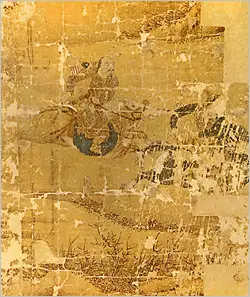Gongmin of Goryeo
| Gongmin of Goryeo | ||||||||
|---|---|---|---|---|---|---|---|---|
| ||||||||
| Pen name | ||||||||
| ||||||||
| Birth name | ||||||||
|
King Gongmin (1330 – 1374) ruled Goryeo (Korea) from 1351 until 1374. He was the second son of King Chungsuk. In addition to his various Korean names (see right), he bore the Mongolian name Bayàn Temür (伯顔帖木兒).
Background
Goryeo had been a dependency of the Mongol Yuan Dynasty since Mongol invasion of Korea. Starting with King Chungnyeol, prospective rulers of Korea married Mongol princesses and were customarily sent to the Yuan Court, in effect, as hostages. As per this custom, King Gongmin spent many years in the Yuan court, being sent there in 1341, before ascending the Korean throne. He married the Mongol princess Queen Noguk (노국대장공주, 魯國大長公主). But in the mid-14th century Yuan was beginning to crumble, soon to be replaced by the Ming dynasty in 1368.
Reform
With the disintegration of Yuan, which had dominated the Korean peninsula since the Mongol invasions of Korea of 1238, Gongmin began efforts to reform Goryeo government. His first act was to remove all pro-Mongol aristocrats and military officers from their positions. These deposed people formed a dissident faction which plotted an unsuccessful coup against the king. High official Jo Il-sin even tried to take over the government, but this rebellion was put down by general Choe Yeong.
Between the 1250s and the 1270s, Mongols had annexed northern provinces of Korea after the invasions and incorporated them into their empire as Ssangseong (쌍성총관부, 雙城摠管府) and Dongnyeong (동녕부, 東寧府). In 1356s, Goryeo army retook these province partly thanks to defection from Yi Ja-chun, a minor Korean official in service of Mongols in Ssangseong, and his son Yi Seonggye. In addition, Generals Yi Seonggye and Ji Yongsu led a campaign into Liaoyang.
A second internal problem was the question of land holdings. The land-grant system had broken down, and Mongol-favoured officials, along with a handful of landed gentry, owned the vast majority of agricultural land, which was worked by tenant farmers and bondsmen. However, King Gongmin's attempt at land reform was met with opposition and subterfuge from those officials who were supposed to implement his reforms, as they were landowners themselves.
The third problem was that the Wokou who had been troubling the peninsula for some time were no longer hit-and-run bandits, but had become well-organised military marauders raiding deep into the country. Generals Choe Yeong and Yi Seonggye were called upon by Gongmin to combat them.
The fourth problem were the Red Turban troops, which invaded Goryeo two times in the years(1359 and 1361). In 1361, the Red Turban troops occupied Kaesong for a short period, but escaped with bare life by general Choe Yeong, Yi Seonggye, Jeong Se-Un, Yi Bang-Sil.
It was during the reign of Gongmin that a Goryeo diplomat stationed in China named Mun Ik-jom managed to smuggle cotton seeds back into Goryeo, introducing them to the Korean peninsula for the first time.
Death
After the death of his wife Queen Noguk in 1365, he got depressed in sadness. In the end, he was indifferent to politics and entrusted a great task to monk Shin Don (신돈, 辛旽). However, after six years, Shin Don lost his position.
Gongmin was famous for his predilection for falling in love with boys. He is reputed to have spent his time in the practice of Buddhism and relations with boys, establishing an organization for their recruitment. [1]
Goryeo's entrenched bureaucracy never forgave King Gongmin for his reform efforts. They interpreted his policy of cutting all ties with the Yuan and establishing relations with Ming China as a direct threat to their status and feared that further attempts at reform might yet be made. Kaesong's deposed pro-Mongol faction battled to protect its position and hoped to renew ties with the Mongols who had helped them gain and hold their wealth in the first place. in 1374, he was killed by his young men, Choi Man-Seng (최만생) and some young men he was recently having relations with. One of the young men, Hong Ryun (홍륜) had relations with one of Gongmin's concubines, which led to Gongmin's anger. So before Gongmin could kill him, Hong Ryun and Choi Man-Seng killed Gongmin in his sleep.
After his death, a high official Yi In-im was assume the helm of government. and Yi enthrone the eleven-year-old King U.
Although he did not receive a temple name of an emperor, because the political situation of the time following his death did not recognize him as such, he proclaimed himself an emperor as a part of reformations he undertook in order to reinstate Goryeo's position as an independent nation. [citation needed]
The Korean TV drama Sin Don features a depiction of King Gongmin.
See also
- List of Korea-related topics
- History of Korea
- List of Korean monarchs
| Preceded by: Chungjeong |
Ruler of Goryeo 1351-1374 |
Succeeded by: U |
Credits
New World Encyclopedia writers and editors rewrote and completed the Wikipedia article in accordance with New World Encyclopedia standards. This article abides by terms of the Creative Commons CC-by-sa 3.0 License (CC-by-sa), which may be used and disseminated with proper attribution. Credit is due under the terms of this license that can reference both the New World Encyclopedia contributors and the selfless volunteer contributors of the Wikimedia Foundation. To cite this article click here for a list of acceptable citing formats.The history of earlier contributions by wikipedians is accessible to researchers here:
The history of this article since it was imported to New World Encyclopedia:
Note: Some restrictions may apply to use of individual images which are separately licensed.
